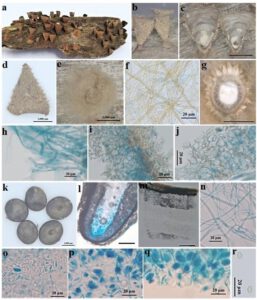Cyathus striatus (Huds.) Willd., Fl. berol. prodr.: 399 (1787)
Index Fungorum number: IF211223;
Description
Known distribution – Throughout the world.
Material examined – INDIA, Arunachal Pradesh, Papum Pare, Doimukh, 27°08’22.1″N 93°46’07.1″E on 18 September, 2020, on decaying wood, collected by Naniya Takha, identified by Niranjan. M. Specimen voucher number: ARFR-151, deposited in Department of Botany, Rajiv Gandhi University, Arunachal Pradesh.
Notes – Das & Zhao (2012) provided the key to Indian Cyathus species that are mainly differentiated by the number of peridial layers. Present specimen contained three layered peridium, peridiole covered with tunica, basidiospores longer than 15 μm, and is similar to C. ellipsoideus, C. intermedius and C. striatus. Further, based on morphological characters, the collected specimens shared similar Basidial and Peridial characters with C. striatus. However, in comparison to the previous report (Sharma 2016),the basidiospores of the specimen of C. striatus in our collection were slightly larger (13.5–19.0 × 9.6–12.0 (13.4) vs. 11–18 × 9–12 μm) but with thinner wall (2.4–3.3 vs. ~3.5 μm). Therefore, the key morphological characters do ensure that it fits into C. striatus, and this species has been recorded for the first time in Arunachal Pradesh.
Importance and role:
As Cyathus striatus is a saprobe on unknown decaying twigs it plays a vital role in ecosystems in recycling nutrients.
Biochemistry:
There appears to be no known biochemical studies on Cyathus striatus.
Contributors: Niranjan.M and Singh.R.K.
Fig. 1 – Cyathus striatus (ARFR-151). a, b Basidiomata. c Endoperidium. d Exoperidium.
e Immature basidia. f Stipe associated hyphae. g Stipe section. h-j Peridial layers. k Peridioles with funiculi. l, m Cross section of peridiole. n Funiculus hyphae. o Sub-cortex section of peridiole. p-q Basidiospores. r Basidiospores. Scale bar: c, g = 3000 μm, d-e = 2000 μm, l-m = 40 μm.

